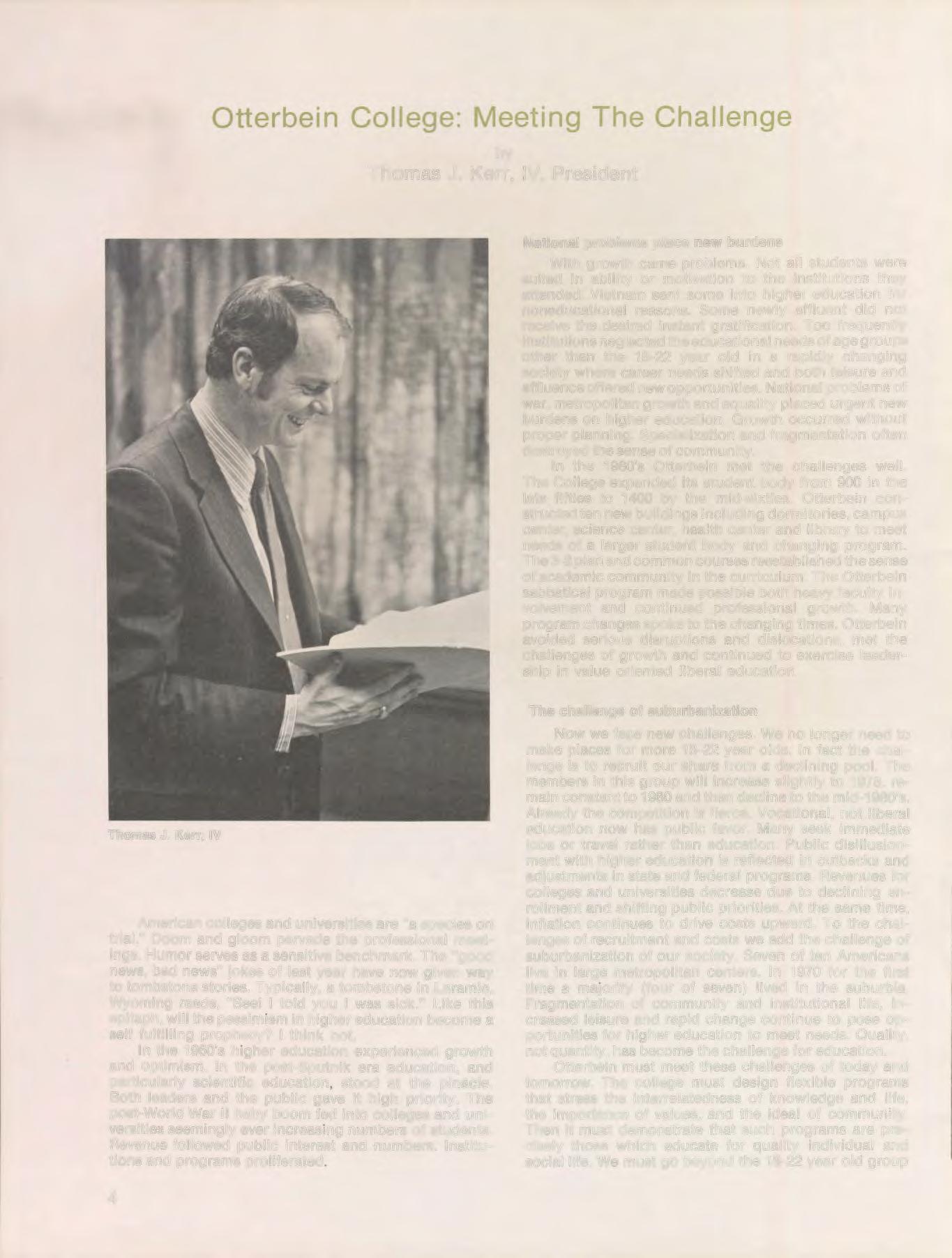
5 minute read
Otterbein College: Meeting the Challenge
Otterbein Col I ege: AP.ting The Challenge
by Thomas J. Kerr, IV, President
Thomas J. Kerr, IV

American colleges and universities are "a species on trial." Doom and gloom pervade the professional meetings. Humor serves as a sensitive benchmark. The "good news, bad news" jokes of last year have now given way to tombstone stories. Typically, a tombstone in Laramie, Wyoming reads, "See! I told you I was sick." Like this epitaph, will the pessimism in higher education become a self fulfilling prophecy? I think not.
In the 1960's higher education experienced growth and optimism. In the post-Sputnik era education, and particularly scientific education, stood at the pinacle. Both leaders and the public gave it high priority. The post-World War II baby boom fed into colleges and universities seemingly ever increasing numbers of students. Revenue followed public interest and numbers. Institutions and programs proliferated.
National problems place new burdens
With growth came problems. Not all students were suited in ability or motivation to the institutions they attended. Vietnam sent some into higher education for noneducational reasons. Some newly affluent did not receive the desired instant gratification. Too frequently institutions neglected the educational needs of age groups other than the 18-22 year old in a rapidly changing society where career needs shifted and both leisure and affluence offered new opportunities. National problems of war, metropolitan growth and equality placed urgent new burdens on higher education. Growth occurred without proper planning. Specialization and fragmentation often destroyed the sense of community.
In the 1960's Otterbein met the challenges well. The College expanded its student body from 900 in the late fifties to 1400 by the mid-sixties. Otterbein constructed ten new buildings including dormitories, campus center, science center, health center and library to meet needs of a larger student body and changing program. The 3-3 plan and common courses reestablished the sense of academic community in the curriculum. The Otterbein sabbatical program made possible both heavy faculty involvement and continued professional growth. Many program changes spoke to the changing times. Otterbein avoided serious disruptions and dislocations, met the challenges of growth and continued to exercise leadership in value oriented liberal education.
The challenge of suburbanization
Now we face new challenges. We no longer need to make places for more 18-22 year olds. In fact the challenge is to recruit our share from a declining pool. The members in this group will increase slightly to 1978, remain constant to 1980 and then decline to the mid-1980's. Already the competition is fierce. Vocational, not liberal education now has public favor. Many seek immediate jobs or travel rather than education. Public disillusionment with higher education is reflected in cutbacks and adjustments in state and federal programs. Revenues for colleges and universities decrease due to declining enrollment and shifting public priorities. At the same time, inflation continues to drive costs upward. To the challenges of recruitment and costs we add the challenge of suburbanization of our society. Seven of ten Americans live in large metropolitan centers. In 1970 for the first time a majority (four of seven) lived in the suburbia. Fragmentation of community and institutional life, increased leisure and rapid change continue to pose opportunities for higher education to meet needs. Quality, not quantity, has become the challenge for education.
Otterbein must meet these challenges of today and tomorrow. The college must design flexible programs that stress the interrelatedness of knowledge and life, the importance of values, and the ideal of community. Then it must demonstrate that such programs are precisely those which educate for quality individual and social life. We must go beyond the 18-22 year old group
and provide an educational opportunity to those who missed that opportunity upon high school graduation or who have new educational needs as their stage of life and their society change. We must strengthen our relationship to the Columbus metropolitan area and maximize the educational opportunities it offers our students. Internships, inter-institutional programs, such as our current one with Grant Hospital School of Nursing, and community service projects are illustrative. We are in the center of action. Westerville, now approaching 15,000, has doubled in size in the past decade. Our curriculum must reflect concern for suburban problems and life. The co-curricular programs must more clearly meet educational goals. Our residence hall program must emphasize educational program, group living and group responsibility. In a rapidly changing world learning how to learn must take priority over quantitative knowledge. We must find new sources of financial support for the College to assure program quality and innovation and to make fiancial aid available to those who could not attend without it.
I am optimistic about the ability of Otterbein to meet future challenges. The College has the resources to merit such optimism. Equality of opportunity, spiritual values, sense of community, openness and adaptability are resources of tradition. With the completion of the 125th year campaign construction programs including the Rike Physical Education Center, the renovation of the Alumni Gym as a teaching-learning center and the renovation of Towers Hall, the College will have an efficient and adaptable physical plant to implement program and attract students. The Venture Into Opportunity campaign itself shows that the College has resource potential. In less than a year over $1 .75 million has been pledged or given toward the three year $2.3 million goal. Individuals have given because of what Otterbein meant to their lives. Foundations and business leaders have shown new interest in Otterbein goals and programs. We still have much to do, but the commitment and concern give encouragement.
Most of all, human resources merit optimism. The loyalty of Otterbein alumni and friends is excellent. Many have given sacrificially of time, talents and treasure to the VIO campaign. Regularly, numerous alumni and friends recruit students and share ideas. The faculty and staff consistently provide leadership professionally and in personal commitment. More than 100 pledged over $76,000 to the campaign beyond their daily service. Faculty have demonstrated remarkable professional growth through the sabbatical program, ensuring that Otterbein will continue to offer a high quality academic program. Students have shown high responsibility in their governance roles.
The road ahead is not an easy one. In an earlier time of great challenge, John F. Kennedy reminded us, "We should not let our fears hold us back from pursuing our hopes." I have high hopes for Otterbein. With your help, Otterbein will meet the challenges of tomorrow.
Rike Physical Education Center - Shown is an interior view of the planned new Rike Physical Education Center to be built with Venture into Opportunity funds including the $300,000 contribution of the Rike Foundation. It is hoped that a date for
the ground-breaking can be announced on Alumni Day, June 9.












